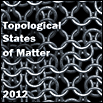Speaker
Masatoshi Sato
(Institute for Solid State Physics, University of Tokyo)
Description
Recently, there is much interest in Majorana fermions (MFs)
in topological superconductors (TSCs). MFs were originally
introduced as elementary particles such neutrinos, but no
elementary particles have been identified as MFs yet. Now it
has been known that MFs can be realized as topologically
protected surface states of TSCs. In this talk, I will report on
our works of MFs in TSCs.
Although spin-triplet superconductors had been known to
host MFs, recently it was found that even s-wave
superconducting states may support MFs [1] if the spin-
orbit interaction is taken into account [2]. By combing with
Zeeman magnetic fields, one finds that the system
hosts chiral MFs on its surface and Majorana zero modes in
a vortex, which implies the non Abelian topological order.
This scheme was first established in Ref [1], and later
applied to various systems. Very recently, an experimental
realization of MFs based on this scheme was reported in a
nanowire system [3].
In this talk, I discuss MFs of the recent discovered
superconducting topological insulator (STI), CuxBi2Se3,
which is expected to be an odd-parity superconductor. From
the Fermi surface criterion [4], surface helical MFs have
been predicted. Here we develop a theory of
the tunneling spectroscopy for STIs [5]. Based on the
symmetry and topological nature of parent topological
insulators, we find that the MFs in the STIs have a profound
structural transition in the energy dispersions .We clarify
that MFs in the vicinity of the transitions give rise to robust
zero bias peaks that is consistent with the recent
experimental result [6] of the tunneling conductance.
[1] M. Sato et al, Phys. Rev. Lett. 103, 020401 (2009);
Phys. Rev. B
82, 134521 (2010).
[2] M. Sato, S. Fujimoto, Phys. Rev. B 79, 094504 (2009).
[3] L. Kouwenhoven, Nature, News 483, 132 (2012).
[4] M. Sato, Phys. Rev. B 81, 220504(R) (2010).
[5] A. Yamakage, K. Yada, M.Sato, Y. Tanaka, Phys. Rev.
B85, 180509(R) (2012)
[6] S.Sasaki et al, Phys. Rev. Lett. 107, 217001 (2011).

